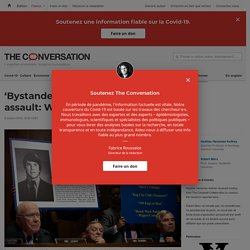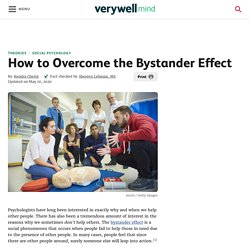

Let's explore what the "Bystander effect" is and determine whether it is possible to resist the inaction!
A Summary of the Bystander Effect: Historical Development and Relevance in the Digital Age. This article provides a historical perspective on the bystander effect, a social phenomenon that Darley and Latané first studied experimentally in 1968.

[1964, The New York Times] Queens Woman Is Stabbed To Death in Front of Home. [2007, American Psychologist] The Kitty Genovese Murder and the Social Psychology of Helping - The Parable of the 38 Witnesses. [2017, Association for Psychological Science] The Killing of Kitty Genovese: What Else Does This Case Tell Us? Britannica. Verywellmind.com. If you witnessed an emergency happening right before your eyes, you would certainly take some sort of action to help the person in trouble, right?

While we might all like to believe that this is true, psychologists suggest that whether or not you intervene might depend upon the number of other witnesses present. What Is the Bystander Effect? The term bystander effect refers to the phenomenon in which the greater the number of people present, the less likely people are to help a person in distress.
When an emergency situation occurs, observers are more likely to take action if there are few or no other witnesses. Being part of a large crowd makes it so no single person has to take responsibility for an action (or inaction). [Definition] Diffusion of responsibility. [Video] Diffusion of Responsibility. [Definition] Pluralistic Ignorance. Pluralistic Ignorance Definition Pluralistic ignorance occurs when people erroneously infer that they feel differently from their peers, even though they are behaving similarly.
![[Definition] Pluralistic Ignorance](http://cdn.pearltrees.com/s/pic/th/pluralistic-iresearchnet-172550225)
As one example, imagine the following scenario: You are sitting in a large lecture hall listening to an especially complicated lecture. After many minutes of incomprehensible material, the lecturer pauses and asks if there are any questions. No hands go up. [Video] Pluralistic Ignorance. Family Violence. It’s a community issue, and we can all choose to stay silent – or act to end abuse.

We round up a recent NVPC Giving Matters conversation on family violence. This article is written by our volunteer writer, Mona Thyagarajan, MSW. Dr Sudha Nair, founder of Pave, at an NVPC Giving Matters conversation on family violence Domestic violence is terrorism in the home. Strong words, perhaps, but there’s no other way to describe the systematic use of physical and verbal violence against a family member, PAVE founder Dr Sudha Nair states. Domestic violence is not just domestic. But cultural norms may be to shy away from interfering or “being kaypoh” in people’s family issues. Dr Nair also spoke of the “bystander effect”, citing a famous case in which over 50 witnesses to a brutal assault did not take any action – because each of them assumed someone else would. So, the issue is not whether to intervene, as that seems to be clear. Bullying in School. An attack on a Syrian refugee teenager in the United Kingdom, captured in a widely-shared video, has sparked global outrage and prompted a crowdfunding campaign that has raised more than $175,000 for the family.

The video, posted on Tuesday, showed the 15-year-old, whose arm is in a sling, being throttled by another teenager, and then wrestled to the ground at Almondbury Community School in Huddersfield city. Sexual assaults. Sexual assault, pushed into public conversation by the #MeToo movement, once again dominates the U.S. news cycle.

Supreme Court nominee Brett Kavanaugh faces allegations that he sexually assaulted professor Christine Blasey Ford, a former high school classmate. The allegations have led to a number of important questions regarding victim testimony, the veracity of memory and the justice system in America. However, as social scientists who study sexuality and violence, we found ourselves asking a different question: Where were Kavanaugh and Ford’s classmates during this alleged incident? The role of bystanders Based on Dr. Over 50 years of research has documented a “bystander effect” in which witnesses fail to intervene in emergency situations, often because they assume someone else will take action.
Under mandate of the 2013 United States Campus Sexual Violence Elimination (SaVE) Act college campuses across the United States have begun implementing bystander training programs. Global Warming. Not too long ago, I was preparing a lecture about group dynamics for my students at Delft University of Technology.

Singaporean Eye Power (feat. Steven Lim) Would You Step In? THE BYSTANDER EFFECT. Participating in Bystander Intervention Programmes. The likelihood of a victim's survival will increase more than threefold with intervention.

PHOTO: ST FILE SINGAPORE - A study has found that three measures, when applied together, have more than doubled the likelihood of bystanders performing cardiopulmonary resuscitation (CPR) on cardiac arrest victims in Singapore. Dispatch-assisted CPR, CPR and automated external defibrillator training, and the Singapore Civil Defence Force's myResponder app were found to have increased the responses of bystanders giving life-saving assistance to heart attack victims before paramedics attended to them.
Countering Pluralistic Ignorance - Asking the right questions at the right time in the right way. Picture this: You're in an important meeting with senior leadership.

The CEO is sharing the firm's strategic plan, including how the company will "leverage big data to gain visibility into market opportunities producing measurable ROI". Um...what? You do a quick scan around the conference room. Heads nod in agreement as the CEO concludes. Self-doubt kicks in. Overcoming Bystander Effect as a Bystander. Psychologists have long been interested in exactly why and when we help other people.

There has also been a tremendous amount of interest in the reasons why we sometimes don't help others. The bystander effect is a social phenomenon that occurs when people fail to help those in need due to the presence of other people. In many cases, people feel that since there are other people around, surely someone else will leap into action.1 While the bystander effect can have a negative impact on prosocial behavior, altruism and heroism, researchers have identified a number of different factors that can help people overcome this tendency and increase the likelihood that they will engage in helping behaviors.2 Some of these include: Witnessing Helping Behavior Sometimes just seeing other people doing something kind or helpful makes us more willing to help others.
Imagine that you are walking into a large department store. Use Technology to combat the bystander effect. The responsibility to help during an emergency falls on anyone present and capable of lending a hand. If You Need Help, You'd Better Ask For It. Picture this. You’re out hiking in the wilderness—all alone and miles from civilization. You turn a corner on the trail and come upon a young man in torn clothes, looking disheveled and a little incoherent.
You’re on your way to your campsite, but he clearly needs help. Be a Bystander Hero.